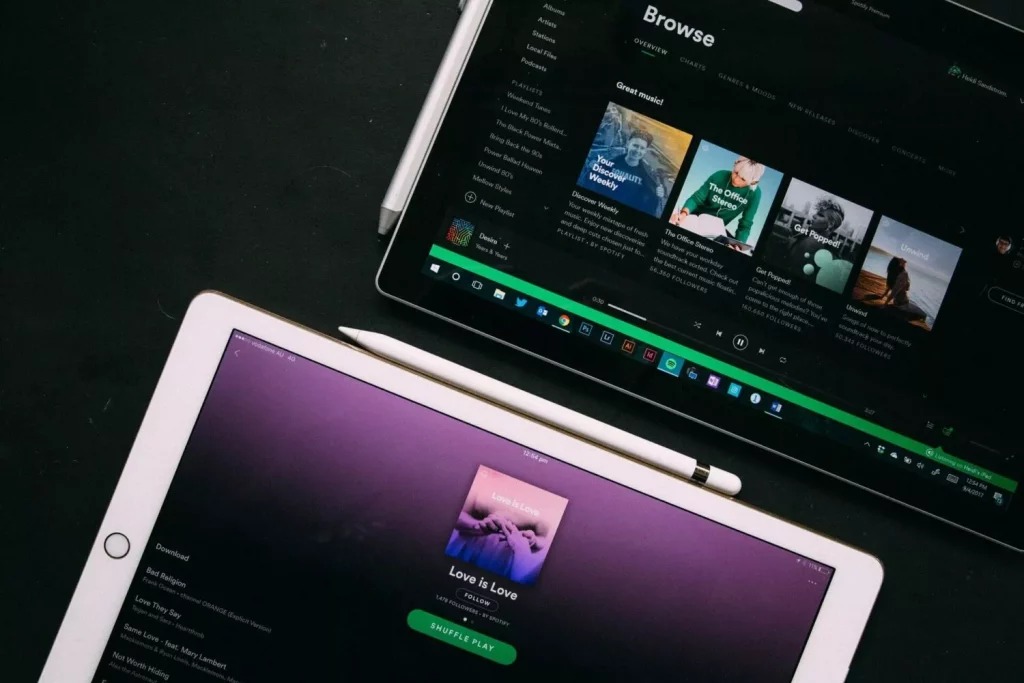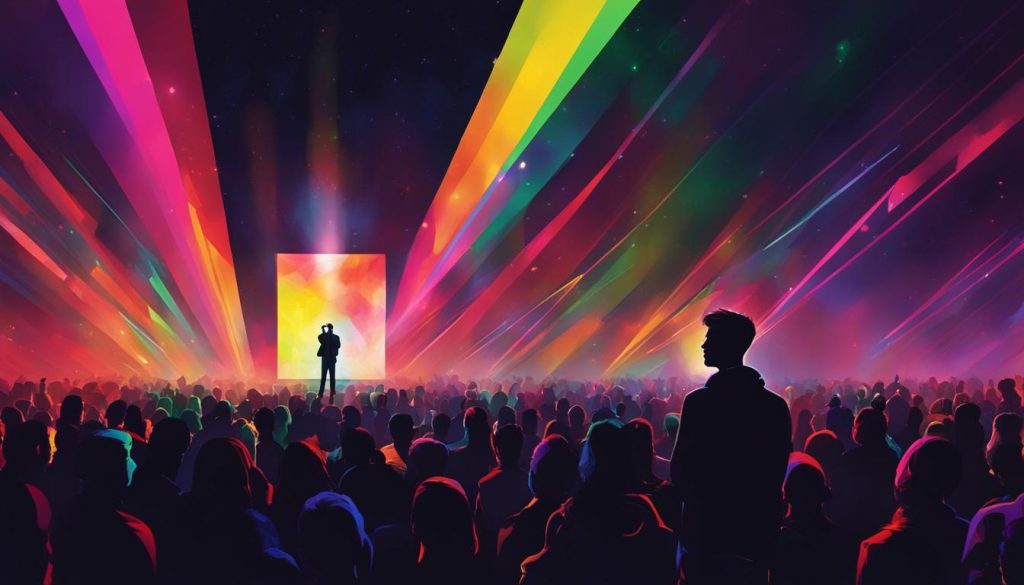Have you ever wondered who listens to your Spotify playlists? Or how Spotify curates personalized recommendations just for you? In this article, we dive into the fascinating world of Spotify’s algorithm and explore how it unravels listener insights.

Spotify’s algorithm is a masterpiece of engineering, blending user interactions, curated playlists, and audio analysis to create a unique and personalized music experience. But what role does user data play in this process? How does Spotify track and analyze listener behavior?
Join me as we uncover the secrets behind Spotify’s algorithm and understand how you can optimize your Spotify experience to discover new music, create personalized playlists, and embrace the diversity of musical genres.
But first, let’s address the burning question: Does Spotify tell you who listens to your playlist? Let’s find out!
Key Takeaways:
- Spotify’s algorithm combines user interactions, curated playlists, and audio analysis to create a personalized music experience.
- User data is the cornerstone of Spotify’s algorithm, shaping music recommendations based on individual preferences and context.
- Playlist curation on Spotify involves a collaboration between AI and human expertise, resulting in diverse and enjoyable music experiences.
- Spotify goes beyond genre labels and analyzes the audio characteristics of each track to offer nuanced recommendations.
- By actively engaging with the algorithm and curating personalized playlists, users can optimize their Spotify experience and discover new music.
The Role of User Data in Spotify’s Algorithm
When it comes to creating a personalized music experience, user data plays a crucial role in Spotify’s algorithm. Every action a user takes, from playing to skipping, saving to exploring different tracks, is carefully recorded and analyzed. This wealth of data allows Spotify to understand individual music preferences, streaming habits, and overall user interactions.
By harnessing Spotify user data, the algorithm evolves and adapts to deliver music recommendations that align with each user’s unique taste, mood, and context. This user-centric approach ensures that Spotify provides a personalized and enjoyable music experience for millions of listeners.
Understanding user interactions is vital in shaping the algorithm’s decision-making process. The data collected helps the algorithm identify patterns, explore correlations, and make connections between different songs and artists. By analyzing user data, Spotify can provide accurate and diverse recommendations that cater to individual music preferences.
For example, Spotify considers factors such as the songs played, skipped, and saved by a user, along with the amount of time dedicated to each track. By analyzing these data points, the algorithm can offer music recommendations that reflect a user’s unique taste and preferences, creating a more tailored and satisfying music journey.
Through the integration of Spotify user data, the algorithm not only strives to understand and adapt to individual preferences but also aims to introduce listeners to new and relevant music. By tracking user interactions and music preferences, Spotify can create discovery features like the “Discover Weekly” playlist, which introduces users to new artists and genres based on their listening history. This combination of personalization and discovery ensures a well-rounded music experience that caters to the diverse interests of Spotify users.
As Spotify continues to refine its algorithm and gather more user data, user interactions will remain essential in shaping the future of music discovery and recommendation. By staying attuned to the preferences and streaming habits of its users, Spotify can continue to deliver a seamless and enjoyable music experience for all.
Playlist Curation – A Blend of Human and AI
When it comes to Spotify, playlist creation is an art that seamlessly combines the power of AI and the expertise of human curators. This unique blend allows Spotify to offer a truly personalized music experience, making it one of the most popular streaming platforms in the world.
Imagine waking up every Monday to a fresh playlist perfectly curated to your taste, introducing you to new tracks that feel like they were handpicked just for you. That’s the magic of Discover Weekly, a playlist created by Spotify’s algorithm based on your listening habits and compared with similar users. It’s a musical journey that keeps evolving and surprising, ensuring that you’ll never get stuck in a musical rut.
But Spotify doesn’t stop at Discover Weekly. They go a step further with their Daily Mix playlists. These playlists are designed to adapt to your changing moods and preferences throughout the day, providing a mix of your favorite songs and related tracks that keep the music flowing seamlessly. It’s like having your personal DJ that knows exactly what you want to hear next.
The beautiful thing about Spotify’s playlist creation is the collaboration between AI and human curators. While AI takes care of the heavy lifting, analyzing vast amounts of data and making complex calculations, human curators bring their deep understanding of music to the mix. They add that human touch, ensuring that every playlist is diverse, enjoyable, and filled with undiscovered gems.
This collaboration creates a harmonious balance between the efficiency and accuracy of AI algorithms and the creativity and intuition of human curators. It’s this combination that makes Spotify’s playlists so exceptional, invoking a sense of familiarity while continuously surprising listeners with new music.
So the next time you find yourself lost in the world of Spotify playlists, take a moment to appreciate the harmony between AI and human collaboration. It’s this perfect blend that allows Spotify to create a personalized music journey just for you.
Audio Analysis – Understanding Music Beyond Genre
Spotify’s algorithm is not confined to genre labels; it goes a step further by delving into the audio characteristics of each track. Through meticulous analysis of factors like tempo, key, and dynamics, Spotify gains a granular understanding of music. This comprehensive audio analysis enables Spotify to provide nuanced recommendations that take into account not only user preferences but also the intrinsic qualities of the music itself.
By deciphering music beyond genre, Spotify offers a more diverse and enriching musical experience for its users. While genres give a broad classification, they don’t capture the intricacies and unique traits that define a song. Spotify’s audio analysis, on the other hand, delves into the very essence of the music, allowing for more precise and personalized recommendations.
The tempo of a track determines its pace and energy, influencing the overall mood it creates. Spotify’s audio analysis takes this into account to curate playlists that align with listeners’ desired tempo, ensuring the perfect soundtrack for any moment.
Understanding the key of a song is essential for seamless transitions between tracks. Spotify’s algorithm analyzes the key of each song to create playlists that flow harmoniously, catering to users’ preferences and enhancing their listening experience.
Dynamics in music refer to the variation in volume between different sections of a song. By analyzing dynamics, Spotify determines tracks that possess a similar sound profile and recommends them accordingly. This deep understanding of dynamics allows users to explore an eclectic mix of music that shares similar sonic qualities.
Through advanced audio analysis, Spotify’s algorithm empowers users to venture beyond the realm of genres and explore the essence of music. By recognizing the significance of tempo, key, and dynamics, Spotify curates playlists that resonate with individuals on a much more personal level, creating a truly immersive musical journey.
Unlocking the Secrets of Music through Audio Analysis
By deciphering the tempo, key, and dynamics of each track with precision, Spotify’s algorithm reveals a wealth of information about the music we love. This audio analysis transcends genre boundaries, allowing for a more comprehensive understanding of the intricacies that make each song unique. As a result, Spotify users are treated to a diverse and enriching musical experience tailored to their individual preferences.
How to Use Spotify’s Algorithm to Your Advantage

Optimizing your Spotify experience and discovering new music is easier than you think. By actively engaging with Spotify’s algorithm, you can curate a personalized music profile that caters to your individual preferences.
One way to optimize your Spotify experience is by providing feedback to the algorithm. By liking, disliking, and replaying songs, you help the algorithm understand your music taste and deliver more tailored recommendations. This action not only enhances your current listening experience but also improves future recommendations.
To further refine your music profile, consider creating personalized playlists. By curating playlists based on your favorite genres, moods, or activities, you can discover new music while helping the algorithm understand your preferences better. The more you engage in playlist creation, the more accurate and diverse your recommendations become.
Exploring new genres and artists is another effective way to optimize your Spotify experience. Step out of your comfort zone, and embrace different musical styles. Spotify’s vast music library offers a world of musical possibilities waiting to be explored. By venturing into uncharted territories, you may uncover hidden gems and fall in love with new genres.
So, take control of your Spotify journey by actively engaging with the algorithm, curating personalized playlists, and embracing new genres. Let the power of Spotify’s algorithm enhance your music discovery and create a tailored music experience that truly reflects your unique taste.
The Science Behind Spotify’s Recommendations
Spotify’s recommendation engine is at the core of its personalized music journey. The platform uses advanced technologies like collaborative filtering, Natural Language Processing, and The Echo Nest to curate tailored recommendations for each user.
The Spotify recommendation engine leverages collaborative filtering to connect users with similar tastes. By analyzing the listening habits and preferences of millions of users, Spotify identifies patterns and suggests songs that users might enjoy. This collaborative approach ensures that the recommendations are relevant and aligned with individual preferences.
Natural Language Processing (NLP) plays a crucial role in understanding the cultural context and lyrics of songs. Spotify’s NLP algorithms analyze the lyrics and consider the meaning, sentiment, and cultural references embedded in the words. This analysis helps Spotify make informed recommendations that align with the user’s mood and interests.
The Echo Nest, a music intelligence platform acquired by Spotify, adds another layer of sophistication to the recommendation engine. The Echo Nest conducts detailed music analysis based on factors like rhythm, timbre, and harmony. This analysis helps Spotify identify songs that share similar musical characteristics, allowing for a more diverse and rich recommendation experience.
By combining collaborative filtering, Natural Language Processing, and The Echo Nest, Spotify creates a powerful recommendation engine that fuels a personalized music journey for each user. The algorithm considers not only user preferences and similar tastes but also the lyrics, cultural context, and intricate musical elements. This comprehensive approach ensures that Spotify users get to discover new music that resonates with them on a deeper level.
Maximizing Visibility on Spotify

As an artist on Spotify, increasing your visibility is crucial for growing your fan base and gaining recognition in the music industry. By implementing effective strategies, you can ensure that your music reaches a wider audience and resonates with listeners worldwide.
Consistently updating your artist profile is essential. This enables you to showcase your latest releases, share your story, and provide fans with valuable insights into your creative process. By keeping your profile up-to-date and engaging, you can entice listeners to explore your music and connect on a deeper level.
“Sharing behind-the-scenes stories and interacting with fans helps forge a deeper connection.”
To further enhance your visibility, create engaging content that captivates your audience. This can include behind-the-scenes footage, live performances, exclusive interviews, or even interactive Q&A sessions. By offering unique and exciting content, you can build a loyal fan base who eagerly anticipates your next release.
Additionally, optimizing your tour planning based on fan demographics and engagement can significantly boost your visibility. By analyzing streaming data and fan interactions, you can identify regions where your music resonates the most and strategically plan your live shows. This targeted approach ensures that you perform in locations with a high concentration of fans, maximizing your impact and exposure.
It’s important to leverage Spotify’s algorithms by actively engaging with the platform. By understanding how the algorithms work and tailoring your approach, you can increase the chances of your music appearing in personalized recommendations and playlists. This exposure can lead to more streams, followers, and ultimately, a broader reach for your music career.
By maximizing your visibility on Spotify through consistent profile updates, creating engaging content, optimizing tour planning, and leveraging Spotify’s algorithms, you can connect with a global audience and establish yourself as an artist to watch. Take advantage of the platform’s immense potential and showcase your talent to the world.
Social Media Synergy in Music Promotion
Social media platforms, such as TikTok, Instagram, and Twitter, play a crucial role in promoting music and driving viral success on Spotify. These platforms provide artists and marketers with valuable opportunities to connect with listeners and gain global exposure.
By leveraging the power of social media, artists can create authentic and shareable content that resonates with their audience. This content, when carefully crafted, has the potential to go viral, reaching millions of potential fans. With the ability to share music tracks, behind-the-scenes footage, and engaging stories, artists can forge deeper connections with their audience and encourage active engagement.
Platforms like TikTok offer a unique space for music discovery and promotion. The app’s short-form videos and trending challenges allow artists to showcase their tracks in creative ways, often leading to viral sensations. Instagram provides opportunities for artists to engage with their audience through visually appealing posts, stories, and live streams. Twitter, on the other hand, facilitates real-time conversations about music, allowing artists to engage directly with fans and build a loyal following.
This synergy between Spotify and social media plays a vital role in amplifying the reach of tracks and fostering global conversations about music. As tracks gain popularity on social media platforms, they attract the attention of both casual listeners and music industry professionals. This increased visibility and buzz can lead to opportunities such as collaborations, brand partnerships, and record deals.
Furthermore, social media serves as a channel for artists to connect with their existing fan base and build new relationships. By engaging with fans through comments, direct messages, and live interactions, artists can create authentic connections and nurture a dedicated community. These engaged fans often become strong advocates, sharing the artist’s music with their own followers and amplifying its reach even further.
When used effectively, the synergy between Spotify and social media enables artists to promote their music to a global audience, foster authentic connections with fans, and potentially achieve viral success. By capitalizing on the power of social media platforms, artists can propel their music careers and create lasting impressions in the ever-evolving digital landscape.
Authentic Engagement and Community Building
Creating a thriving community and fostering authentic connections is essential for achieving viral success on Spotify. As an artist, it’s crucial to interact with your fans and make them feel like valued members of your community. By engaging with your audience, you can build genuine connections that go beyond just the music.
One effective way to engage with your fans is through live streams, where you can perform, chat, and answer questions in real-time. Live streams create a sense of intimacy and allow fans to interact with you directly, fostering a deeper connection. Additionally, hosting Q&A sessions gives fans the opportunity to get to know you on a personal level, creating a sense of authenticity and building trust.
Another great strategy for community building is sharing behind-the-scenes content. By giving fans a glimpse into your creative process, studio sessions, or tour preparations, you provide them with exclusive insights and make them feel like insiders. This transparency helps establish a loyal and dedicated fan base that is emotionally invested in your success.
Nowadays, social media platforms play a vital role in building communities and engaging with fans. It’s important to leverage these platforms to create memorable and authentic interactions. Responding to comments, messages, and mentions on platforms like Instagram, Twitter, and TikTok shows that you value your fans’ input and appreciate their support. This active engagement helps strengthen the bond between artist and fans, leading to increased fan loyalty and advocacy.
Building a Dedicated Fan Base

By consistently engaging with your fans and building a sense of community, you can cultivate a dedicated fan base that will support and promote your music. These enthusiastic fans are more likely to share your tracks with their network, increasing the potential reach and impact of your music. The power of word-of-mouth cannot be underestimated, and an engaged fan base can help propel your career forward.
Authentic connections with your fans are crucial in the age of social media, where listeners crave genuine interactions and experiences. By fostering these connections and creating a tight-knit community, you can establish yourself as an artist who goes beyond just releasing music. You become an artist who genuinely cares about their fans and values the relationship.
So, take the time to engage with your fans authentically, create a sense of community, and build lasting connections. By doing so, you’ll not only create viral success on Spotify but also establish a loyal fan base that will support you throughout your musical journey.
How AI and Data Science are Revolutionizing Music Patterns
AI and data science are transforming the music industry, ushering in a new era of innovation and personalization. Through sophisticated music recommendation algorithms, listening habits are analyzed to provide tailored song suggestions and curated playlists. This level of customization allows music platforms to deliver an immersive and individualized music experience to each user.
Predictive analytics play a crucial role in anticipating hit songs, helping artists, labels, and platforms make data-driven decisions on music production and promotion. By analyzing vast amounts of data, including streaming patterns, social media trends, and user preferences, data insights optimize revenue streams and enhance overall industry profitability.
While AI-generated music doesn’t aim to replace musicians, it offers a unique creative dimension and expands the boundaries of music consumption. AI algorithms can compose original compositions, experiment with sonic landscapes, and even simulate different musical styles. This fusion of human and artificial creativity opens up exciting possibilities for musicians and listeners alike.
Data science plays a vital role in understanding music trends and audience preferences. By analyzing vast datasets, music platforms can identify emerging genres, predict listener behavior, and tailor recommendations to match individual tastes. This data-driven approach enhances user engagement and helps artists reach their target audience more effectively.
One example of how AI and data science are revolutionizing the music industry is through the development of AI-generated music platforms. These platforms leverage machine learning algorithms to compose original tracks, catering to specific moods, genres, or preferences. By blending data science with artistic expression, AI-generated music platforms offer users a novel and diverse musical experience.
The integration of AI and data science is reshaping the music industry, empowering artists, platforms, and listeners with enhanced creativity, personalization, and revenue optimization. As technology continues to advance, we can expect exciting developments in AI-generated music and data-driven music experiences.
Emblem Technologies x AI Music
Emblem Technologies introduces Needle, an innovative music streaming platform that revolutionizes the music listening experience. Powered by cutting-edge AI and data analytics, Needle goes beyond traditional streaming platforms to deliver personalized playlists and recommendations tailored to each user’s unique music preferences.
With its advanced AI capabilities, Needle analyzes vast amounts of user data, including listening history, favorite artists, and genres. This deep understanding enables Needle to curate playlists that align perfectly with individual tastes, ensuring a truly customized music journey.
Moreover, Needle’s data analytics provide invaluable insights to music labels and platforms, helping them understand user behavior, preferences, and emerging trends. This information empowers the industry to make data-driven decisions and optimize their offerings to meet the evolving demands of music enthusiasts.
One of Needle’s standout features is its ability to connect music lovers with similar tastes. By fostering music mate connections, Needle creates a vibrant social experience where users can discover new music and connect with like-minded individuals who share their passion for specific genres, artists, or songs. This unique social aspect adds an exciting community-driven element to the music streaming experience.
